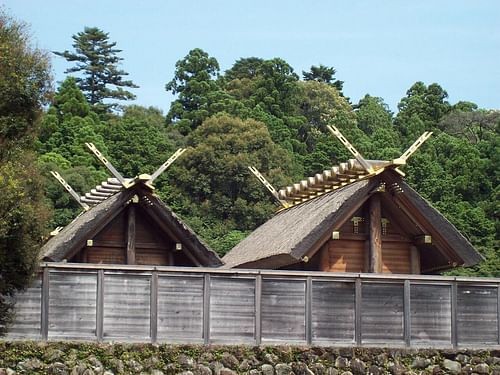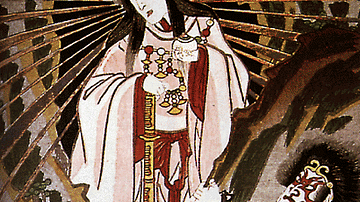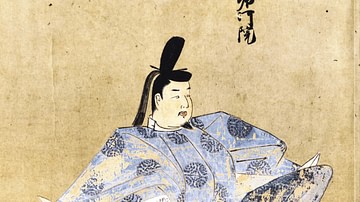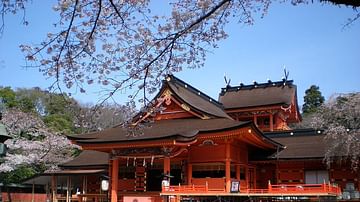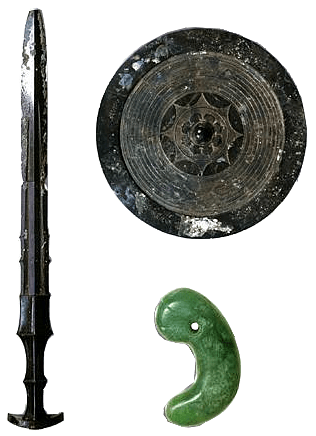
Ninigi-no-Mikoto, or simply Ninigi, is the grandson of the supreme Shinto deity Amaterasu, the sun goddess. He is the son of Ama-no-Oshiho-mimi and, descending to earth as the first just ruler, he brought with him gifts from Amaterasu as symbols of his authority which remain part of the Japanese imperial regalia today. Ninigi became the great-grandfather of Japan's first emperor, the semi-legendary Emperor Jimmu, and so established a divine link between all subsequent emperors and the gods.
Ninigi Descends from the Heavens
In Japanese mythology, the sun goddess Amaterasu Omikami asked her son Ama-no-Oshiho-mimi to descend from the heavens to rule the world of the mortals. Twice refusing this honour after seeing the general chaos that prevailed in the world, Ama-no-Oshiho-mimi nominated his son Ninigi-no-Mikoto (full name: Ame-Nigishi-Kuninigishi-Amatsu-hiko-no-ninigi-no-mikoto) to go in his place. To this Amaterasu finally agreed, and she gave Ningi three gifts to help him on his way. These were the Yasakani, a fabulous jewel (or pearls or magatama beads), source of the ancient quarrel between Amaterasu and her brother Susanoo, the storm god; the Yata, the mirror which had been made by the gods and successfully used to tempt Amaterasu out of the cave which she hid in following some typical bad behaviour from Susanoo; and Kusanagi, the great sword Susanoo had plucked from a monster's tail. These would become the three emblems of Ninigi's power (sanshu no jingi), and they became the imperial regalia of his descendants, the emperors of Japan, starting with his great-grandson Emperor Jimmu (r. 660-585 BCE). Thus, all subsequent emperors were able to claim a direct descent from the gods and so legitimise their authority to rule Japan.
The celebrated 7th-century CE poet Kakinomoto Hitomaro composed this poem on Ninigi's descent to govern humanity:
At the beginning of heaven and earth
The eight hundred, the thousand myriads of gods
Assembled in high council
On the shining beach of the Heavenly River,
Consigned the Government of the Heavens
Unto the Goddess Hirume [Amaterasu], the Heaven-
Illuminating One,
And the government for all time,
As long as heaven and earth endured,
Of the Rice-abounding Land of Reed Plains
Unto her divine offspring,
Who, parting the eightfold clouds of the sky,
Made his godly descent upon the earth.
Manyoshi (Keene, 104-105)
Amaterasu also gave Ninigi some specific instructions regarding the Yata mirror: "Consider this mirror as thou wast wont to consider my soul, and honour it as myself" (Hackin, 395). Eventually, the mirror would indeed become an object of worship or shintai and end up in the Ise Grand Shrine in the Mie Prefecture, dedicated to Amaterasu and still today Japan's most important Shinto shrine.
Ninigi, carrying his three precious goods, and accompanied by three gods (including Ame-no-uzume, the dawn goddess, and Sarutahiko-no-kami, the god of crossroads) and five chiefs, landed on earth at the top of Mt. Takachiho, in the south of Kyushu. From there, after first building himself a palace, he went to the temple of Kasasa in Satsuma province where the five chiefs set about laying down the principles of the Shinto religion, creating a priesthood and organising the building of temples. The chiefs would pacify the land and establish the clans which would dominate Japanese government for centuries to come such as the Fujiwara clan. In this capacity, the five became the ancestral deities of these clans, the ujigami.
Ninigi & Sakuya-hime
Ninigi quickly found romance on earth when he bumped into the girl Sakuya-hime, and he immediately proposed marriage. The girl faltered, telling Ninigi she first had to have permission from her father. The god obliged and went to the girl's home nearby. The father (who in some versions is the mountain god Oyamatsumi-no-kami) gave a rather cryptic response to Ninigi's request and offered him the choice of his two daughters or both. The other girl, Iwanaga-hime, was not quite the stunner her younger sister was, and so Ninigi stuck with his first choice. The father, angered that he had chosen the weaker of his two girls, anyway consented but not before he set a curse on the offspring of the couple that they would be mortal, a detail which explains why all emperors are both divine but 'short-lived'.
Before very long a baby was on the way, but Ninigi had doubts as to whether he was the child's father. A haughty Sakuya-hime assured her husband the child was his and to prove her point locked herself away in a hut. In a dramatic gesture, she then set fire to the hut and they both survived, thus proving the child was of divine birth. Ninigi's son was given the name Hoderi-no-mikoto. Sakuya-hime, also known as Konohanasakuya-hime, later became the goddess and resident kami of Mount Fuji.
The god would have two more sons: Ho-suseri and Hoho-demi (akak Hoori). The latter would have a son with Toyo-Tama-bime (daughter of the sea god Wata-tsu-mi) but the child was abandoned and brought up by his aunt Tama-yori-bime who then married him. They had four sons and the youngest, Toyo-mike-nu (aka Kamu-Yamatoihare-hiko-no-mikoto), would become Japan's first emperor, his posthumous title being Emperor Jimmu Tenno, who traditionally reigned from 660-585 BCE, thus establishing a royal line which could claim divine descent.
This content was made possible with generous support from the Great Britain Sasakawa Foundation.
